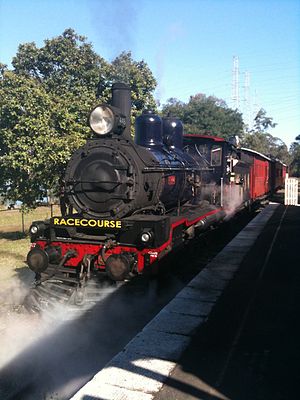- Queensland PB15 class locomotive
-
Queensland PB15 class 
PB15 No. 448 at Swanbank Power type Steam Designer Henry Horniblow and L. W. Piggott. Builder Evans, Anderson, Phelan & Co. (70,)
Ipswich workshops (1),
Kitson & Co. (20),
Toowoomba Foundry (20), Walkers Ltd (122)Build date 1899–1926 Total produced 233 Configuration 4-6-0 UIC classification 2′C n2 Gauge 3 ft 6 in (1,067 mm) Driver diameter 48 in (1.22 m) Length 47 ft 6 in (14.48 m) Axle load 8 long tons (8.1 t) Water capacity 2,500 imperial gallons (11,000 l; 3,000 US gal) Boiler pressure 160 psi (1.10 MPa) Firegrate area 12 sq ft (1.1 m2) Heating surface:
Tubes and flues780 sq ft (72 m2) Superheater type None Cylinders Two, outside Cylinder size 15 × 20 in (381 × 508 mm) Valve gear Stephenson (locos built 1899–1912)
Walschaerts (locos built 1924–26)Tractive effort 12,750 lbf (56.71 kN) Career Queensland Railways Number 347–362, 385–384, 404–413, 434–509, 518–537, 540–609, 12, 5, 103, 126, 128, 143, 220, 286, 339, 340, 731–751 Disposition Five preserved, remainder scrapped The PB15 class locomotive was a 4-6-0 locomotive of the Queensland Railways. The locomotives operated on 1,067 mm (3 ft 6 in) gauge.
Contents
Overview
The design resulted from a need for more powerful engines for passenger trains. The PB15 Class was designed by Locomotive Engineer, Henry Horniblow and L. W. Piggott. The “P”, which was used to denote “Passenger”, was added to the classification of the new locomotives to distinguish them from the earlier B15 Class, which were primarily goods engines. The “B”, is used to identify the number of coupled wheels, being six coupled wheels for the PB15 class, followed by numerals indicating the cylinder diameter of fifteen inches. The PB15s were in essence identical to the B15s.
Variations
The first PB15 engines were delivered by Walkers Ltd, Maryborough in April 1900. The original locomotives delivered between 1900 and 1912 were fitted with Stephensons Valve Gear. Walkers Ltd manufactured a further 30 improved PB15 Class locomotives between 1924 and 1926 and these were fitted with Walschaerts Valve Gear. This earned this variant of the PB15 the nickname Walschaerts. At the height of their service there were approximately 230 locomotives in service in Queensland.
Preservation
Five have been preserved:
- No. 444 is on display at the Workshops Rail Museum, in Ipswich, Queensland.
- No. 448 is operational on the Queensland Pioneer Steam Railway, Swanbank, Queensland.
- No. 454 is undergoing a major overhaul at the Bellarine Peninsular Railway, Queenscliff, Victoria.
- No. 732 is in storage at the QR Heritage Fleet's Ipswich Railway Workshops, Ipswich, Queensland.[1] One of the 1924 Walschaerts.
- No. 738 is on display at the Rosewood Railway Museum, Rosewood, Queensland. One of the 1924 Walschaerts.
Builders
Some of the class were built at Ipswich workshops and some by Walkers Limited, Engineers, Maryborough, Queensland.
See also
- Rail transport in Queensland
- List of Queensland steam locomotives
References
External links
- PB15-class Queensland's Railways Interest Group.
- Queensland Pioneer Steam Railway
Queensland rail rolling stock Queensland Railways steam locomotive A10 Baldwin • A10 Fairlie • A10 Ipswich • A10 Neilson • A14 • AC16 • B12 • B13 • B18¼ • BB18¼ • C16 • C17 • C19 • D17 • DD17 • PB15 • Beyer-GarrattDiesel locomotive Electric locomotive QR National electric locomotivesElectric multiple unit EMU • ICE • IMU • SMUCategories:- Queensland steam locomotives
- Locomotives used in Queensland
- Steam locomotives of Australia
- 4-6-0 locomotives
- Railway locomotives introduced in 1899
- Kitson locomotives
- Queensland rail transport stubs
Wikimedia Foundation. 2010.
